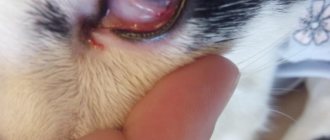Cat owners may not always understand that their pet needs urgent treatment due to hidden symptoms of the disease. These conditions include hematuria – the appearance of blood in a cat’s urine for various reasons. As a rule, this problem often goes unnoticed in time, since the animal urinates in a tray with filler, where it is almost impossible to distinguish the color of the urine. And even having noticed a brownish tint to the urine, not every owner understands the seriousness of this phenomenon. However, it is important to pay close attention to, as hematuria indicates that your cat is in need of emergency medical attention.
Symptoms of hematuria
The cat's discharge should be transparent and have a yellow-orange tint. If the owner finds blood in the cat’s urine, this indicates an inflammatory process or other problems in the animal’s body that need to be eliminated. First of all, it is necessary to find out why there was blood in his urine, and then begin treatment.
In order to be able to control the color of the cat’s excrement, it is worth teaching him to pee on an empty tray or choose a light-colored litter. Pink, brown or red urine with possible blood clots indicates problems with the animal's health. Deep-colored urine results from an excess of red blood cells, which indicates inflammation in the body.
In addition to the fact that there is blood in the cat’s urine, hematuria may have the following symptoms:
- lack of appetite;
- lethargy and apathy;
- increased body temperature;
- the animal urinates past the tray onto furniture and carpeting;
- When a cat pees, nervousness is observed in its behavior as a result of painful urination.
Red urine may be the result of your cat eating carrots or beets. In this case, you don't need to do anything. The most reliable method for determining the presence of blood in urine is a laboratory test for red blood cells.
Collecting urine for analysis
Red discharge in cats indicates serious illnesses that may require long-term treatment. The first thing the animal owner needs to do in this situation is to collect urine for analysis. After this, you need to show the cat to the veterinarian, and send the finished material for research. For laboratory tests, urine collected no earlier than 3-4 hours ago is suitable.
Rules for collecting analysis:
- The tray must first be rinsed with hot water;
- The filler is either removed altogether, or small sea pebbles are placed at the bottom of the pot;
- The finished urine is poured into a clean container and submitted for analysis no later than 4 hours after collection;
- The animal must be fed no later than 6 hours before the test is taken.
Symptoms to help recognize the problem
The first sign of the disease is a frequent urge to urinate, but little urine comes out.
When a cat pees constantly and little, and bloody impurities are observed, this indicates a problem. A healthy pet's urine color has a slight yellowish or orange tint. In the early stages, hematuria often remains unnoticed, since in addition to blood, no other signs are recorded in the urine. Soon the animal begins to pee frequently drop by drop and an additional clinical picture is observed:
- problems with appetite;
- high body temperature in cats;
- apathetic and lethargic state;
- restlessness during urination;
- urine with mucus and blood;
- reluctance to pee in the tray, as a result of which the owners find small puddles throughout the house.
Why is this happening
Blood in a cat’s urine is an indicator of a serious condition of the body or a disease, the development of which could be provoked by certain reasons. The veterinarian will identify them during laboratory and computer examinations. As a rule, hematuria develops as a result of various infections, diseases and injuries.
The main causes of hematuria leading to serious consequences:
- the presence of bacterial infections and diseases of the genitourinary system, such as urolithiasis, cystitis, pyelitis or urethritis;
- intrauterine anomalies in the development of internal organs, especially the kidneys;
- severe damage to the kidneys and bladder by worms and other parasites;
- damaged internal organs as a result of impacts, injuries or falls from a height;
- poisoning by poor-quality food, poisons, medications;
- hypothermia or overheating of the body;
- the presence of a malignant tumor;
- diseases of the cardiovascular system.
Determining the cause of blood in the urine is of great importance, since further treatment and the speed of recovery of the animal depend on this.
Depending on the causes, the following types of hematuria are distinguished:
- Renal parenchymal hematuria is a consequence of kidney problems. These can be diseases of varying degrees of complexity, injuries, inflammations, infections, tumors and other anomalies.
- Hematuria is a pathology of the urinary tract - its causes are the presence of bacteria in the urine, infections of the bladder, urethra, ureter, as well as tumors, injuries, inflammation and other problems in the functioning of these organs.
- Hematuria from diseases of the genital tract - darkening of urine with vaginal discharge in cats or inflammation of the prostate in cats.
- Hematuria as a result of a systemic disease - pink or red urine in this case appears after diseases of the liver, cardiovascular system, or other pathologies such as overheating, hypothermia, excessive physical exertion.
Regardless of the type of hematuria, treatment should be carried out in a hospital or at home exclusively under the supervision of a doctor.
Diagnostics
To identify the cause of the presence of blood in urine and make an accurate diagnosis on the basis of which treatment will be prescribed, the veterinarian must conduct a thorough examination. First, a visual inspection of the cat is carried out. If the owner was unable to first collect urine for analysis, this can be done in a clinic using a catheter.
Examination methods and tests for hematuria:
- General urine analysis - indicates an excess of red blood cells and other dangerous impurities in the cat’s excretions and the presence of an inflammatory process;
- Biochemical blood test - indicates problems in the kidneys;
- Coagulogram – determines the level of blood clotting;
- Sensitivity and urine culture - helps to determine the presence of infection in the urine and select the right antibiotic;
- Ultrasound of the abdominal cavity - determines the presence of tumors, stones and infections;
- X-ray with contrast - allows you to detect anomalies, tumors and stones of the genitourinary system;
- X-ray of the abdominal cavity - indicates the presence of stones in the organs of the urinary system;
- Cystoscopy – allows you to examine the condition of the urethra and bladder from the inside;
- Analysis of stones or histology of a removed tumor (if detected) - based on the data from these tests, the doctor prescribes a specific treatment.
Why the problem is alarming: veterinarians name the main reasons
When a cat pees in small portions with blood, this is the first sign of the development of a serious disease in the urinary system. The problem is often observed in castrated cats. The disorder is caused by urolithiasis. Some owners believe that the development of pathology is influenced by dry food in the diet, but veterinarians dispel this myth and focus on the fact that the main source of the problem is low-quality products, and good food is not capable of causing the disease. In a sterilized and normal cat, bloody urine is a consequence of problems with excess weight, lack of activity and other factors against which urolithiasis progresses.
An equally common reason why a cat experiences frequent urination with blood clots is mechanical damage to the organ. The problem appears after a fall, sterilization, or auto injury. There are other factors that cause a kitten to urinate blood:
- Infectious diseases. When an infection enters the bladder, urethra, or kidneys, the pet pees red or pink urine. A young cat encounters this disorder, but more often the infectious pathology affects adults who are over 7 years old.
- Neoplasms. If a cat often walks around in a small way, and urine comes out drop by drop and with blood, then this indicates tumor processes. The tumor can be benign and malignant, with the latter having a less positive prognosis.
- Cystitis of the idiopathic type. British Fold, Scottish and other cat breeds suffer from inflammation in the bladder. Owners find that the pet constantly marks throughout the house, meows loudly and urine comes out in small amounts with blood.
First aid for detecting blood in a cat's secretions
What to do in a situation where it is not possible to immediately show the animal to a veterinarian? The answer is simple: do not self-medicate. It is advisable to try to contact the doctor by telephone to receive detailed recommendations and, if necessary, prescribe a pain reliever. You also need to take actions that will help alleviate your pet’s condition.
First aid for hematuria:
- Provide the cat with peace by placing it in a dry, clean room;
- Provide access to clean water for drinking;
- Feed the animal liquid food;
- Give your cat a decoction of bearberry or parsley, which has disinfectant properties;
- Decoctions of juniper and horsetail will help reduce inflammation of the urinary tract.
It is unacceptable to treat an animal with antibiotics without a doctor's prescription. It is important to collect tests as early as possible and show the cat to a specialist.
Preventive recommendations
If a cat pees blood and little urine is excreted, then you should not self-medicate. To prevent problems, you should carefully monitor the animal’s diet and avoid obesity. Timely deworming and elimination of fleas from the cat is important. It is recommended to supervise the animal so that it does not fall or suffer other injuries. In order to timely identify abnormalities and blood impurities in urine, it is worth systematically examining your pet and conducting the necessary examinations.
Treatment
After receiving the diagnostic results and visual examination, the veterinarian makes a diagnosis and prescribes the necessary treatment.
Methods to combat hematuria:
- The use of anti-inflammatory, antispasmodic and analgesic drugs;
- For advanced diseases, antibiotics are indicated, administered orally or intramuscularly;
- The use of vitamins, herbal tinctures and drugs to improve immunity;
- The use of drugs to stop bleeding;
- If there are stones in the urinary organs, the animal is prescribed a special diet;
- If the body is dehydrated, intravenous infusions of glucose and physiological solutions are indicated;
- For certain types of poisoning, a veterinarian may prescribe the use of vitamin K1.
- Stones, tumors and other neoplasms are removed surgically;
- If you have problems urinating, you may need to use a urinary catheter.
During pregnancy and after childbirth, the organs of the urinary system can often become inflamed and chronic diseases will worsen, but most medications in this case are contraindicated for use. Therefore, the prescription of treatment should be taken as seriously as possible, because not only the health of the cat, but also its unborn kittens depends on it.
Normal changes that occur in the body
In some cases, bloody discharge is observed in a cat for reasons related to natural processes. Such circumstances do not pose a threat to the health of the animal. Such changes include the following:
- Estrus. This process is accompanied by an increase in the pet’s activity. The female often arches her back, rolls around on the floor, and becomes playful. It is absolutely normal for a cat to have bloody discharge during estrus. After this period ends (as a rule, this happens after a few days), the symptom disappears completely.
- Bearing offspring. The presence of this sign in a pregnant female indicates a restructuring of the body and preparation for the birth of cubs. However, intense discharge indicates the development of serious pathological processes.
Prevention
Although pink urine can occur for a variety of reasons, there are not many methods to prevent this phenomenon. Almost all of them involve careful care of the animal.
Measures to prevent the appearance of blood in the urine of cats:
- The animal must receive the required amount of nutrients from food, so it is very important to monitor its diet and variety in the menu;
- It is necessary to take timely preventive measures against the appearance of worms and fleas, as well as get the necessary vaccinations on time;
- The risk of falling from a height, hitting or fighting should be minimized;
- Walking outside must be supervised. You should walk in a safe area;
- It is necessary to systematically check what type of urine the cat urinates and whether there is any blood in it;
- At the first signs of any disease, you should immediately take your pet to the veterinarian and begin treating it;
It is important to remember that treating a serious disease is much more difficult than preventing it in the early stages.
How to collect urine from a cat
To begin with, it is worth saying that under no circumstances should you collect urine from the floor using rags or even sterile cotton wool. The fact is that all the signs of the disease remain on the cotton wool, even if you squeeze it out. The same applies to a rag, which, moreover, can mix something into the analysis.
The urine itself is collected in a sterile tray, thoroughly washed with boiling water. It cannot be washed with household chemicals. The urine is then collected in a needleless syringe, which is available at any pharmacy. It is important that it is packaged and not previously used. It is worth protecting yourself from contamination and infections, so it is recommended to carry out the entire procedure with sterile rubber gloves.
The liquid from the syringe should be transferred to a sterile test collection jar, which is also sold in pharmacies.
If the individual characteristics of the cat do not allow the procedure to be carried out and urine collected correctly, the hand of an experienced veterinarian is required. He will collect the analysis using a catheter.
Other signs associated with hematuria
The owner needs to take a closer look at the pet's behavior. If a cat starts going to the toilet in the wrong place, then there is a high probability that this is not because it is harmful, but there are problems. It may be painful for your pet to pee and the litter box is associated with pain. Therefore, the animal chooses other places, softer ones - a sofa, a blanket.
Most pathologies of the urinary system have similar symptoms.
In addition to changes in the color of urine, the following symptoms indicate the occurrence of the disease:
- It hurts for the cat to urinate, she meows when she goes to the toilet in a small way.
- Can pee only in small portions, but often.
- Doesn't go to the toilet for a long time.
- Takes characteristic poses to urinate.
Systemic symptoms often appear: lack of appetite, vomiting, weakness.
Diagnostics
If you notice a red tint to your pet's urine, you should see a veterinarian. Especially if the animal feels pain. The veterinarian will already determine if the cat is peeing blood, the causes of the condition, and will also prescribe treatment. A number of methods are used.
Diagnostic measures:
- general analysis of urinary fluid;
- biochemical blood test;
- determination of blood clotting;
- culture and urine sensitivity test.
If the doctor doubts the root cause of hematuria, then additional tests are performed. For example, cystoscopy, which is used to check how healthy the urethra is and the condition of the bladder walls. An ultrasound and fluoroscopy of the abdominal organs are performed.
Symptoms appear after sterilization
Typically, such an operation assumes the absence of estrus. However, spotting and sexual activity in a sterilized cat are sometimes observed, which indicates the following conditions:
- Neoplasms in the adrenal or mammary glands.
- The presence of cysts in the uterine area.
- Gradual cessation of hormone activity. These substances may remain in the animal’s blood for some time after surgery. As a rule, after 8 weeks this period ends.
- The presence of gonadal tissue cells in other organs.











